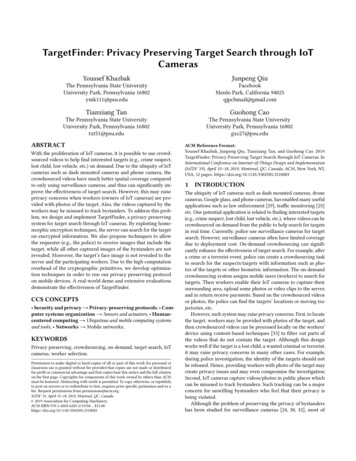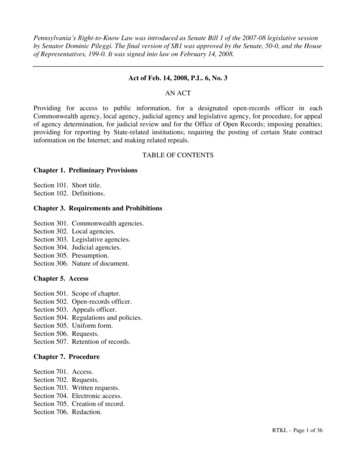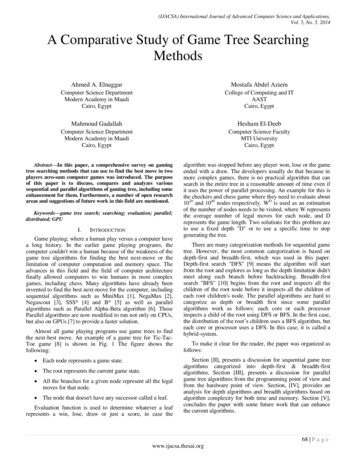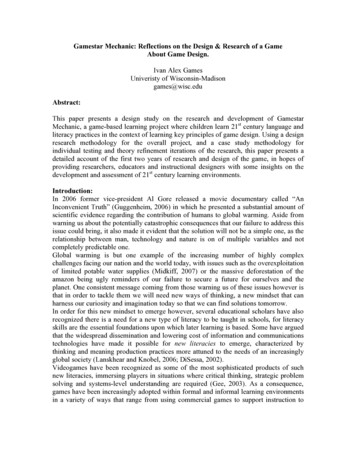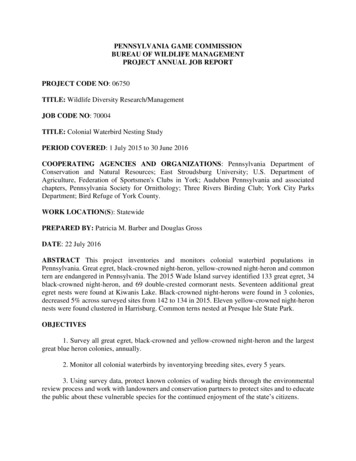
Transcription
PENNSYLVANIA GAME COMMISSIONBUREAU OF WILDLIFE MANAGEMENTPROJECT ANNUAL JOB REPORTPROJECT CODE NO: 06750TITLE: Wildlife Diversity Research/ManagementJOB CODE NO: 70004TITLE: Colonial Waterbird Nesting StudyPERIOD COVERED: 1 July 2015 to 30 June 2016COOPERATING AGENCIES AND ORGANIZATIONS: Pennsylvania Department ofConservation and Natural Resources; East Stroudsburg University; U.S. Department ofAgriculture, Federation of Sportsmen's Clubs in York; Audubon Pennsylvania and associatedchapters, Pennsylvania Society for Ornithology; Three Rivers Birding Club; York City ParksDepartment; Bird Refuge of York County.WORK LOCATION(S): StatewidePREPARED BY: Patricia M. Barber and Douglas GrossDATE: 22 July 2016ABSTRACT This project inventories and monitors colonial waterbird populations inPennsylvania. Great egret, black-crowned night-heron, yellow-crowned night-heron and commontern are endangered in Pennsylvania. The 2015 Wade Island survey identified 133 great egret, 34black-crowned night-heron, and 69 double-crested cormorant nests. Seventeen additional greategret nests were found at Kiwanis Lake. Black-crowned night-herons were found in 3 colonies,decreased 5% across surveyed sites from 142 to 134 in 2015. Eleven yellow-crowned night-heronnests were found clustered in Harrisburg. Common terns nested at Presque Isle State Park.OBJECTIVES1. Survey all great egret, black-crowned and yellow-crowned night-heron and the largestgreat blue heron colonies, annually.2. Monitor all colonial waterbirds by inventorying breeding sites, every 5 years.3. Using survey data, protect known colonies of wading birds through the environmentalreview process and work with landowners and conservation partners to protect sites and to educatethe public about these vulnerable species for the continued enjoyment of the state’s citizens.
700042METHODSVolunteers, cooperators, and Pennsylvania Game Commission biologists counted as manyof the nests in all colonies known to support great egret, and black-crowned, yellow-crownednight-herons. In addition, nests in the largest great blue heron colony were counted, and reports ofnests at other sites were collected opportunistically. Volunteers were recruited through pressreleases, the PABIRDS Listserv, and the Pennsylvania Game Commission website; and used astandard protocol and datasheet. Counts were conducted from the ground at previously and newlyidentified locations. Nests were counted during surveys if they appeared to be active during the2015 breeding season. Newly discovered colonies were entered into the Pennsylvania NaturalDiversity Index for protection through the environmental review process.Great blue heron is not endangered, threatened, or Species of Greatest Conservation Need(Pennsylvania Game Commission and Pennsylvania Fish and Boat Commission 2015), but it isespecially vulnerable to disturbance like other colonial nesting waterbirds. Since coloniesconcentrate populations in small areas they put a high proportion of the population at risk ifdisturbed. Because of their vulnerability and conservation value, larger colonies are trackedannually. A comprehensive statewide survey of great blue heron colonies is not planned again until2017.Educational outreach is a strategy used by the agency to engage the public in reportingheron nests and colonies, especially new ones, and to protect heron colonies through education.The Pennsylvania Game Commission’s website hosts colonial birds pages, including speciesspecific pages for great egret, black-crowned night-heron, yellow-crowned night-heron, andcommon tern, as well as general information on herons and Wade Island. The target audience forthese pages is educators, students, and adults interested in wildlife and conservation.RESULTSThe Wade Island survey in Dauphin County was conducted on 6 May 2015. Leaf out wasnearly complete, making nests difficult to find and assign to species. The survey team found 133great egret, 34 black-crowned night-heron, and 69 double-crested cormorant nests during thesurvey (Fig. 1). Many of the black-crowned night-heron nests were either under construction orrecently completed, suggesting the nesting population was larger than the nests counted in theofficial survey. Surveys of common tern also are included in this report.Great Egret (Ardea alba; Pennsylvania [PA] Status - Endangered)Great egrets were found nesting at 2 locations: Wade Island, Dauphin County and KiwanisLake, York County. At Wade Island, 133 nests were found, similar to the 10-year average of 140nests. With 17 nests at the Kiwanis Lake colony, there were 150 great egret nests found statewidein 2015.Black-crowned Night-Heron (Nycticorax nycticorax; PA Status – Endangered)The black-crowned night-heron population in Pennsylvania continues to be critically lowwith only 3 colonies active in 2015 (Table 1). Colonies are found only in urban or suburban settingsin southeastern counties, and are particularly vulnerable to human disturbance. The majority ofbirds are nesting in 3 locations: Kiwanis Lake, Wade Island, and Ephrata Hospital (Table 1). Blackcrowned night-heron nest numbers decreased 5% across surveyed sites from 142 to 134 in 2015.
700043The Ephrata Hospital colony increased slightly to 68 nests and is now the largest Black-crownedNight-Heron colony in the state. Wade Island formerly the largest colony, decreased to 34 nests.The Kiwanis Lake colony increased to 32 nests. Cumberland County sites were not surveyed in2015. The geographic distribution of the state’s population has drastically constricted from itsformer wider distribution (Master 2012). Any disturbance, human or natural, at these sites wouldjeopardize the species’ persistence and viability in the state.Yellow-crowned Night-Heron (Nyctanassa violacea; PA Status – Endangered)Eleven nests were clustered in or near Harrisburg, Dauphin County. Cumberland Countysites were not surveyed in 2015. Yellow-crowned night-herons continue to demonstrate theirtolerance of some human activities by nesting in mature trees close to human habitation, inbackyards and over roadways in town near the Susquehanna River and its tributaries.Common Tern (Sterna hurindo; PA Status - Endangered)In 2012, after a 40-year absence, common tern returned as a nesting bird to Pennsylvania.In the Gull Point Natural Area at Presque Isle State Park, Erie County, 2 pairs nested in both 2012and 2014. During the 2015 nesting season, the number of individuals fluctuated, with up to 25 to30 individuals seen and a minimum of 8 pairs nested. All of the nests failed due to flooding orpredation.Double-crested Cormorant (Phalacrocorax auritus; PA Status – Secure)The number of cormorant nests on Wade Island decreased 33% to 69 (Fig. 1). However, anew colony was found in Lancaster County with an additional 10 nests, bring the populationstatewide up to 79 nests. Cormorants were removed from Wade Island again in 2015. One hundredforty-six cormorants, 103 adults and 43 juveniles, were culled during the breeding season by U.S.Department of Agriculture Wildlife Services personnel. The management concern is that doublecrested cormorants may displace great egrets and black-crowned night-herons from critical nestingareas and that cormorant guano deposited under nests can kill the trees used by other colonialnesting species of conservation concern (Master 2001, Sullivan et al. 2006). The 2016 cormorantnest count will help evaluate the effectiveness of the 4 full seasons of culling.Great Blue Heron (Ardea herodias)Volunteers and staff reported on 34 great blue heron colonies, totaling 720 nests (Table 1).The Barrows colony is the largest great blue heron colony in the state with 260 nests.Colonial waterbird educational outreachDuring 2015 the Pennsylvania Game Commission colonial waterbird web site speciespages were viewed 9656 times, about half as often as the previous year. We found more nestsand colonies through the contributions of volunteers and conservation partners in part due to theseeducational products and outreach. Since so many colonies are in the urban landscape, thisapproach is essential for successful protection of nests. These are supplemented by articles in thePennsylvania Game News.RECOMMENDATIONS1. Monitor the Wade Island colony and improve protection with additional restricted area
700044signs. Limit annual survey to less than 2 hours to minimize disturbance.2. Survey all colonies of black-crowned night-heron, yellow-crowned night-heron, greategret and the largest great blue heron colonies, annually. Engage volunteers in the surveys tomaximize coverage and interest.3. Educate private landowners hosting colonial waterbird colonies of the value of the birdsand provide them with guidelines for colony protection. Inform Regional Wildlife DiversityBiologists about these colonies and the landowners when possible. Provide more PennsylvaniaGame Commission educational materials, including website pages, to educate the public aboutcolonial waterbird colony protection.4. Maximize protection of nesting black-crowned night-herons at Kiwanis Lake, byworking with Audubon Pennsylvania and the York City Parks Department, and obtain additionalcounts to improve estimate of colony size and survey Lake Williams and Lake Redmond for blackcrowned night-heron nests.5. Continue spring and fall surveys of Barrows colony, ensure protection of nesting habitatand evaluate colony stability.6. Survey islands adjacent to Wade Island for nesting black-crowned night-heron, greategret and double-crested cormorant. Investigate the relationship between cormorants, nightherons, egrets, and colony trees.7. Improve outreach to volunteers and watershed organizations for heron colonyinformation, including identifying new colonies that might otherwise go undetected.8. Monitor Gull Point Natural Area, Presque Isle State Park for common tern nestingactivity and investigate source of predation related to nest failures.LITERATURE CITEDMaster, T. 2001. Threat assessment and management recommendations for Wade Island: amanagement plan. Technical Report. Wildlife Diversity Section, Pennsylvania GameCommission, Harrisburg, USA.Master, T. 2012. Black-crowned Night-Heron, Nycticorax nycticorax. Pages 130–131 in A. M.Wilson, D. W. Brauning, and R. S. Mulvihill, editors. Second Atlas of Breeding Birds inPennsylvania. Pennsylvania State University Press, University Park, USA.Pennsylvania Game Commission and Pennsylvania Fish and Boat Commission. 2015.Pennsylvania Wildlife Action Plan, 2015-2025. C. Haffner and D. Day, editors.Pennsylvania Game Commission and Pennsylvania Fish and Boat Commission,Harrisburg, Pennsylvania.Sullivan, K. L., P. D. Curtis, R. B. Chipman, and R. D. McCullough. 2006. The double-crestedcormorant: issues and management. Department of Natural Resources Cornell University,
700045Ithaca, New York, USA.Table 1. Colonial waterbird sites surveyed in 2015, by species.Site NameSpeciesNestsAdamsgreat blue heron20Bradfordgreat blue heron6Bucks - 1great blue heron1Bucks - 2great blue heron37Bucks - 3great blue heron4Bucks - 4great blue heron34Bucks - 5great blue heron6Bucks - 6great blue heron15Butlergreat blue heron3Chester - 1great blue heron12Chester - 2great blue heron12Chester - 3great blue heron13Chester - 4great blue heron1Cumberlandgreat blue heronMultipleDauphin - 1yellow-crowned night-heron1Dauphin - 2yellow-crowned night-heron1Dauphin - 3yellow-crowned night-heron2Dauphin - 4yellow-crowned night-heron8Dauphin - 5yellow-crowned night-heron1Dauphin - 6great blue heron22Dauphin - 7black-crowned night-heron34Dauphin - 7great egret133Dauphin - 7double-crested cormorant69Jeffersongreat blue heron10Lancaster - 1great blue heron15Lancaster - 2great blue heron12Lancaster - 3double-crested cormorant10Lancaster - 3great blue heron10Lancaster - 4black-crowned night-heron68Lancaster - 5great blue heron28Lancaster - 6great blue heron13Lebanon - 1great blue heron21Lebanon - 2great blue heron8Lehighgreat blue heron30Mercergreat blue heron260Montgomery - 1great blue heron35
700046Table 1. cont.Site NameMontgomery - 2Montgomery - 3NorthamptonVenangoWestmoreland - 1Westmoreland - 2YorkYorkSpeciesgreat blue herongreat blue herongreat blue herongreat blue herongreat blue herongreat blue heronblack-crowned night-herongreat egretNests14430420203217450double-crested cormorantblack-crowned night-herongreat 04200220001998199619941991198919870Figure 1. Colonial bird nests found on Wade Island, Dauphin County,Pennsylvania, 1987-2015 by year and species.
Great blue heron is not endangered, threatened, or Species of Greatest Conservation Need (Pennsylvania Game Commission and Pennsylvania Fish and Boat Commission 2015), but it is . The Ephrata Hospital colony increased slightly to 68 nests and is now the largest Black-crowned Night-Heron colony in the state. Wade Island formerly the largest .



